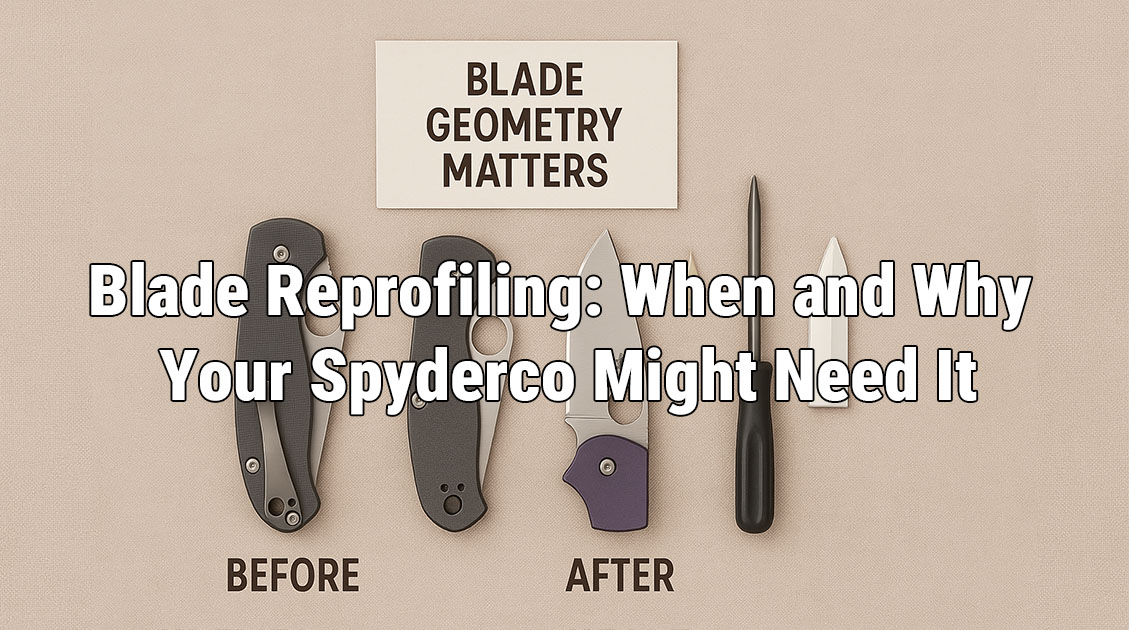Blade Reprofiling: When and Why Your Spyderco Might Need It

This is the 29th blog of the Spyderco blog series. You can check the other blogs I wrote from here – https://spydercoparts.com/blogs
By Logan M. Fraser
Custom Knife Modder & Spyderco Parts Specialist
Based in Calgary, Alberta, Canada
Reprofiling a Spyderco Blade: What It Means and When to Do It
When your Spyderco knife no longer performs like it used to—whether it’s dragging through cardboard or failing to slice through tomatoes cleanly—it might be time to consider blade reprofiling. Reprofiling is more than just sharpening; it’s about changing the edge geometry to restore or enhance performance. In this guide, I’ll walk you through when and why your Spyderco might need reprofiling, how to do it correctly, and what to avoid to preserve the knife’s integrity.
As someone who’s spent years working with Spyderco models like the Para 3, Delica, and Military series, I’ve seen firsthand how transformative a proper reprofile can be. Let’s get into it.
Why Spyderco Knives Sometimes Need Reprofiling 
Spyderco uses premium steels—S30V, LC200N, Maxamet, and others—that hold edges for a long time. But over time and with repeated sharpening, the factory bevels can get misaligned or too thick behind the edge. You might notice:
-
Poor slicing performance despite a “sharpened” edge
-
Uneven bevels due to years of hand sharpening
-
Chipping or micro-rolls on the cutting edge
Reprofiling resets the edge geometry, making future touch-ups easier and improving cutting performance. It’s especially valuable on hard-use models or knives you’ve owned for years.
When Should You Consider Blade Reprofiling?
If any of these sound familiar, it’s time to consider a reprofile:
-
Thick edge after repeated sharpening
-
Visibly uneven bevels
-
Edge doesn’t respond well to sharpening
-
You want to change the angle for specific tasks (e.g., food prep vs. heavy duty)

Choosing the Right Angle for Reprofiling 
Spyderco factory angles range from 15° to 20° per side. Here’s a quick guide:
-
15° per side – Laser sharp for slicing tasks (ideal for kitchen or EDC knives)
-
17–18° per side – Good balance of durability and slicing
-
20° per side – Tougher edge for hard use (military, outdoor work)
For most users, 17° per side is a great middle ground. You get a sharp edge with good longevity.
Tools You’ll Need for Blade Reprofiling 
You don’t need a $500 sharpening system, but precision helps. Here’s what I use:
-
Wicked Edge or KME system – For consistent angles
-
Diamond stones (coarse to fine grits)
-
Leather strop with compound
-
Angle cube (for verifying settings)

Step-by-Step Reprofiling Guide
-
Secure the knife in your sharpening jig or clamp.
-
Set your desired angle. Use an angle cube to verify.
-
Start with a coarse stone (200–400 grit) to establish a new bevel.
-
Raise a burr on one side, then switch.
-
Progress through finer grits (600, 1000, up to 3000 if desired).
-
Strop gently on leather to refine and polish the edge.
-
Test the edge on paper, rope, or shaving arm hair.
If you don’t feel confident doing this, you can send your knife to a trusted modder or professional sharpener.
What NOT to Do When Reprofiling 
-
Don’t change the angle drastically in one session—it removes too much steel
-
Don’t use cheap pull-through sharpeners—they destroy edge geometry
-
Don’t forget to clean your knife thoroughly after reprofiling
-
Don’t use power tools unless you know exactly what you’re doing—heat kills temper
Spyderco Models That Especially Benefit from Reprofiling
Some models arrive from the factory with thicker edges. These benefit greatly:
-
Spyderco PM2 (S110V or Maxamet) – Often has a thick edge, especially in high HRC steels
-
Endura/Delica in VG-10 – Factory bevels are conservative
-
Native 5 Salt in LC200N – Great steel, needs a steeper angle to shine
Reprofiling vs. Sharpening vs. Regrinding
It’s easy to mix up these terms:
-
Sharpening: Refreshing an existing bevel with light touch-up
-
Reprofiling: Changing the edge angle for better geometry or performance
-
Regrinding: Removing material across the blade’s primary bevel (usually done with a belt grinder)
Reprofiling is the sweet spot—it gives you better performance without the drastic change of a full regrind.
Where to Find Reprofiling Services or Gear 
If you’d rather not tackle this yourself, look for services like:
-
**Spyderco Factory Sharpening ** – Great for stock geometry
-
Independent modders or sharpeners on Reddit (r/knifeclub) or Instagram
-
Parts and mods to go along with your fresh edge
Upgrading your washers or replacing a worn-out clip after reprofiling is a smart move—make your knife feel brand new.
Final Thoughts 
Reprofiling might sound intimidating, but it’s a powerful tool in keeping your Spyderco knife at peak performance. Whether you’re prepping meals, carving wood, or just slicing open packages, the right edge makes a world of difference.
If you’ve got questions about angles, tools, or how to pair your fresh edge with the right parts, drop them in the comment section—I’ll do my best to help.
What would you like to learn about in next week’s knife blog? Let me know below!



